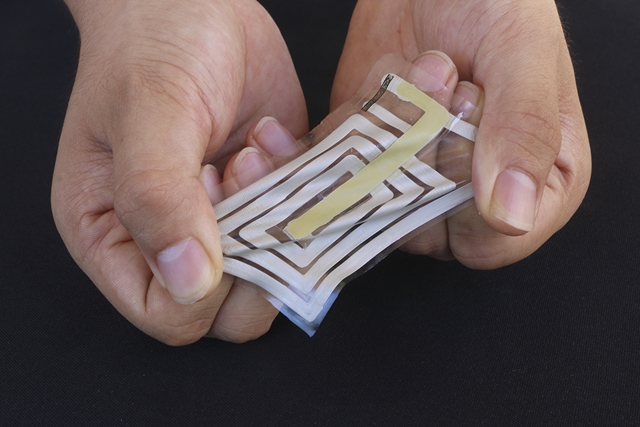16 Aug. 2019. An engineering team designed sensors that stick on the skin and form a network with radio-frequency signals to track physiological functions. Researchers from Stanford University in California and Nanyang Technological University in Singapore describe the sensor network in yesterday’s issue of the journal Nature Electronics (paid subscription required).
A team from the labs of Stanford chemical engineering professor Zhenan Bao and Nanyang materials scientist Chen Xiaodong are seeking more effective techniques for using wearable sensors to capture personalized health data from individuals. The wide use of smartphones provide provide a basic platform for hosting and capturing data from wearable devices, and the researchers aim to provide lightweight, inexpensive, and unobtrusive sensors to record a person’s health indicators. Their sensors need to be comfortable enough for a person to wear, with no rigid circuits nor batteries.
Their solution is a set of sensors on flexible and stretchable plastic that sticks directly to the skin. The sensor circuits are screen-printed on clear, thin plastic that flexes and stretches with the skin. The initial set of circuits reported in the journal paper are designed to measure movements, such as tightening of the skin, and pulse rate. The circuitry includes a radio-frequency antenna that beams the sensor data to a nearby receiver.
Transmitting the sensor data proved to be a particular challenge, say the researchers. The screen-printed antenna is designed to capture power from the nearby receiver, rather than carrying its own power source, one of the design specifications. The flexing and bending of the radio-frequency antenna, however, weakens and destabilizes signals from the sensors.
The team’s solution separated the signal-receiving device from the smartphone. The receiver is now clipped or sewn on clothing very close to the sensor, so it can pick-up even a weak signal. The battery-powered receiver then transfers the data via Bluetooth when pinged by the smartphone.
To prove the concept, the Stanford-Nanyang team asked a volunteer to wear motion sensors that measured breathing and body movement, as well as a pulse-rate sensor. Receivers were clipped on clothing worn over the sensors to capture the data, which were then relayed to mobile systems for analysis and display. The researchers report the sensors simultaneously captured and continuously relayed data from the test sensors for processing.
The team now aims to add sensors for more functions, such as perspiration and body temperature. But the system aims to offer a network of sensors the researchers call BodyNet that can be worn on the skin on various parts of the body, capturing data with receivers woven into clothing, and not necessarily positioned directly over the sensor.
“We think one day it will be possible to create a full-body skin-sensor array to collect physiological data without interfering with a person’s normal behavior,” says Bao in a university statement. The researchers filed a patent for the BodyNet technology.
More from Science & Enterprise:
- Darpa Funds Early Disease Detection System
- Smart Watch, A.I. Analyzing Human Emotions
- Smart Fabrics Boost Wearable Sensor Connections
- Electronic Tattoo Continuously Monitors Blood Pressure
- FDA Clears Wearable App Device for Migraine
* * *


 RSS - Posts
RSS - Posts
You must be logged in to post a comment.